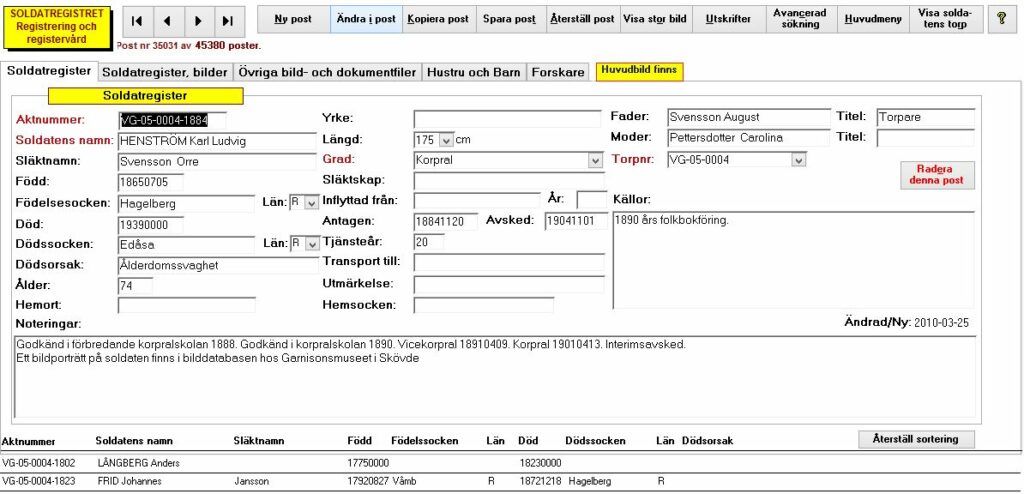The project Central Soldier Register (CS) began on 21 October 1983 at the Diocese and National Library in Skara as a labour market project. It was Major Lennart Larsson who initiated the project and Arne Sträng, the county librarian in Skara, that commissioned Björn Lippold to the task. Björn was to, under the short amount of 6 months, make an inventory of all allotted soldiers and their crofts that had existed in Skaraborg County. The work aimed to find all the soldiers’ crofts that still remained, or the places where the crofts used to be. A total of 1,200 crofts or plots of land were to be inventoried.
Given the scale of the project, more than one person was required to complete the project. Via advertisements in newspapers, the project management asked for help from genealogists and local history researchers to send in information about soldiers that they had in their registers. The response was above expectations, which can be read in the number of soldiers’ names that came in to the project. Of the 35,000 registered soldiers, about 10,000 came from individual researchers in different parts of the country. The project led to many contacts being made with genealogists and local history researchers who later became valuable in the continued work.
In December 1983, the project was presented to Ulf Söderberg at the Military Archives. A special form was produced containing 40 fields about each individual soldier. The design of the form was adapted to also work for data processing of the material.
In the winter of 1989, the former military archivist Erik Norberg was commissioned to organise a central soldier register for the whole country, with placement in Skaraborg. The task was to create a unified approach in the work with the inventory of the soldiers. If new local soldier registers were to be started, they could turn to the Central Soldier Register for advice. The purpose of the central register was to get a good overview of the work that was going on around the country. With a uniform registration process of soldiers thru one single passageway into a nationwide database, a homogeneous picture of the material was brought together. Another aspect was to try to combine academic research with genealogy and local history research. For financial reasons, both the project and Lippold’s employment were transferred at the turn of the year 1990, from Skara Diocesan and Country Library to Skaraborg’s Regiment in Skövde. On 1 July 1990 the Central Soldier Register (CS) was coordinated with the Regiment Museum at Skaraborg’s regiment, which thus became the register’s principal. The principalship lasted until 31 December 2009 when the Garrison Museum in Skaraborg took over the principalship. Lippold also became director of the museum with responsibility for the collections.
In 2012 the Garrison Museum moved to a former retirement home in Axvall. The premises were far too small for the collections and on June 6 2018, the new museum moved to two large buildings on Axevalla heath. The Central Soldier Register was part of the museum’s organization until 2017, when the annual meeting the same year, decided that an independent organization would take over full responsibility for the coordination of all local soldier registers in Sweden. Until further notice, the association is coordinated with the Garrison Museum.
The Soldier Registers is Digitized
In 1987, the forms were digitized and the same year these were transferred to the computer program Pdata Combi and contained approximately 11,000 posts. In the autumn of 1991, all data was migrated to the new database program Avanti.
The local registers received the database program Avanti for installation on their own computers for registration and maintenance of their allotted soldiers.

New Software for Registration
Discussions were held to develop a new database program with new functions, e.g. a clearer and better graphic design with tab systems, the ability to link in images, document, audio and video files in various formats and extended control functions. The Avanti program became increasingly outdated and needed to be replaced. It was decided to develop the new application in the desktop database program Microsoft Access. In the autumn of 2009, the project was completed and after the migration from Avanti to the new database, the finished application was distributed to the local registries for installation.
It was decided that the register would be free of charge for all local registers in exchange for sending data to the Central Soldier Register once or twice a year for publication on the web.

References
Classon, Roland (2011). Här kartläggs soldater [Here soldiers are inventoried], Helsingborgs Dagblad, Monday February 7th, p. C8.
Lippold, Björn, (2008). Knektarna – en viktig del av Sveriges historia [The soldiers– an important part of the Swedish history], Vi släktforskare, Nyhetsbrev för släktforskare, Elisabeth Thorsell (ed.), Year 7, No. 6, pp. 2-3.
Lippold, Björn (1998). Soldatforskning och muntlig tradition [Military research, and oral tradition], in Båtsmän. Ryttare & Soldater: släktforskaren och de militära källorna, Bengt Hjord (ed.), pp. 71-72, Stockholm: Släkthistoriskt forum, No. 5/88.
Lippold, Björn (1993). Soldatregister på data [Soldiers register on data]. Diskulogen med släktforskarnytt, No. 30, pp. 3-5.
Protokoll från Centrala Soldatregistrets styrgruppsmöte 2009-12-04 [Minutes from the steering group meeting 4th of December 2009].
